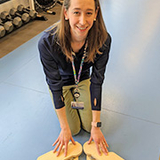Dance Medicine

Dance medicine is a unique niche under the umbrella of sports medicine. Dancers are considered performance athletes, whose training makes them susceptible to distinct types of injuries, both acute and chronic.
At the Sports Medicine and Performance Center at Children's Hospital of Philadelphia, our specialists are trained to care for the youth and adolescent dancer, both male and female. The team understands the physical and technical demands of dance and values the athleticism required.
We incorporate a multidisciplinary team approach in the care of each dancer which may include physical therapists, sports medicine physicians, orthopedic surgeons, and sports nutrition depending on the needs of each dancer. Our team is dedicated to educating professional, student and recreational dancers on preventing dance related injuries and returning them to dance with minimal time lost.
Common dance injuries we treat
Foot and ankle injuries:
Anterior ankle impingement (compression of tissues in the joint)
Posterior ankle impingement
Os trigonum (extra bone in ankle), os trigonum syndrome
FHL tendonitis (flexor hallucis longus tendonitis)
Posterior tibialis tendonitis
Sesamoid stress injury or sesamoiditis
Metatarsal fracture
Lisfranc injuries
Ankle sprains
Achilles tendonitis
Sinus tarsi syndrome
Bone stress injuries, stress fractures
Knee injuries:
Patellofemoral pain (also may be called anterior knee pain or PFPS)
IT band syndrome
Meniscal tears
ACL tears
Pes anserine bursitis
Osgood Schlatter’s
Sinding Larsen Johannson Syndrome
Plica syndrome
Hoffa’s fat pad impingement
Hip injuries:
Labral tears (hip cartilage)
Hip impingement/femoroacetabular impingement (FAI)
Hip instability
Snapping hip syndrome
Hip flexor tendonitis
Greater trochanter bursitis
Pelvic apophysitis
Avulsion injuries
Bone stress injuries
Back injuries:
Spondylolysis (stress injury in one of the vertebrae)
Spondylolisthesis
Apophysitis
Muscle strain
Rehabilitation for dancers
During a dance medicine evaluation, dancers will receive a thorough and complete physical therapy evaluation that will identify any musculoskeletal deficiencies and impairments. Our therapists will complete a detailed dance history and comprehensive physical examination focusing on the neuromotor, biomechanical and physiologic aspects of dance.
Following the evaluation, the physical therapist will develop a unique treatment plan to address the dancer’s specific needs.
Getting Dancers Back on Their Feet
Treatment may incorporate: flexibility, manual therapy, neuromuscular control, and functional strengthening, stabilization and plyometrics within dance specific movements. Our physical therapists are trained to identify improper technique specifically related to dance as well as other functional imbalances that may impact a dancer’s movement pattern.
Our dance medicine specialists see patients at multiple CHOP Specialty Care locations throughout Pennsylvania and New Jersey.

Dance Physical Therapy: Getting Dancers Back on Their Feet
A physical therapist who specializes in dance medicine can shorten recovery time for dancers with a holistic approach.
Community-based services
Our team is available to provide information sessions on dance injury prevention that would be beneficial to dancers, teachers and parents at local dance studios or schools.